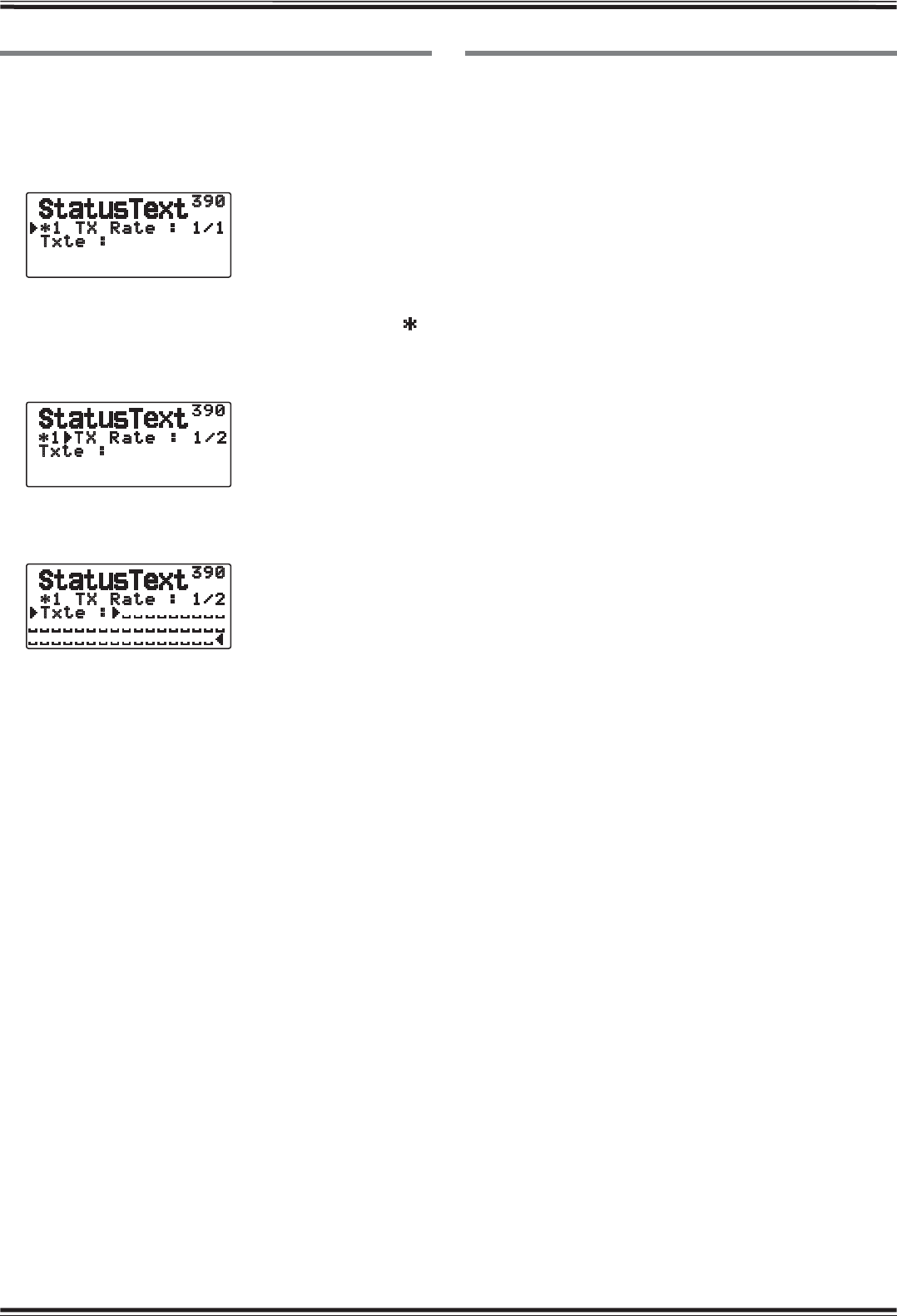
APRS – 13
STORING STATUS TEXT
Status text is another comment to transmit with position
data. Unlike a position comment, you can make any
desired comment using a maximum of 42 alphanumeric
characters. This transceiver has 5 memory channels for
preprogramming.
1 Access Menu 3A0.
2 Select a status text number.
• Press [MHz] to mark the currently used status text with ( ).
3 Select the frequency on which to transmit the status
text when the APRS beacon is transmitted. You can
select “Off” or “1/1” ~ “1/8” (APRS only).
• 1/X means the status text will be transmitted X number of
times.
4 Enter your status text.
QSY FUNCTION
The QSY function uses AFRS (Automatic Frequency
Reporting System) to report a frequency on which voice
communications can be established. A station using
the QSY function embeds the frequency information in a
position beacon transmission. A receiving station of this
information can change frequency, or QSY, over to the
reported voice frequency to begin voice communication by
the select of [Tune].
Transmitting QSY Information
A properly configured functioning TM-D72 QSY station
can automatically embed the voice frequency from the
non-data band to the beginning of status text. This is
the mechanism used for automatically transmitting the
frequency information.
The format of the transmitted frequency is FFF.FFF MHz.
So, for example, if at the time of a beacon transmission,
the non-data band has a frequency of 446.100 MHz
selected, then the frequency of “446.100MHz” gets
embedded to the beginning of the status text. If you
configure in any of Statuses 1 through 4 the frequency
of “446.100MHz” at the beginning of the status text
messages, then this fixed frequency will be transmitted
as QSY information along with the beacon transmission.
In addition to frequencies, there are fields where you
can send other settings such as Wide/Narrow, Tone/
CTCSS/DCS, Shift (+/-), and Offset frequency simply by
-leaving one space between each value. Therefore, other
information besides just a frequency can be sent.
QSY Information Format:
(Insert one space after the frequency before entering
Wide/Narrow, Tone/CTCSS/DCS and Shift/Offset.)
• “T079”: An upper case “T” indicates Wide. Tone frequency of
79.7 Hz. (Encoding)
• “t079”: A lower case “t” indicates Narrow. Tone frequency of
79.7 Hz. (Encoding)
• “tOFF”: A lower case “t” indicates Narrow. Tone = OFF
(Without any tone Encoding or Decoding.)
• “C079”: An upper case “C” indicates Wide. CTCSS
frequency of 79.7 Hz. (Encoding/ Decoding)
• “c079”: A lower case “c” indicates Narrow. CTCSS frequency
of 79.7 Hz. (Encoding/ Decoding)
• “D023”: An upper case “D” indicates Wide. DCS code of 023.
(Encoding/ Decoding)
• “d023”: A lower case “d” indicates Narrow. DCS code of 023.
(Encoding/ Decoding)
• “+” : Plus Shift (A default offset frequency is applied.)
• “-” : Minus Shift (A default offset frequency is applied.)
• “+500” : Plus Shift, 5MHz Offset (“+5000kHz” is also
available)
• “-060”: Minus Shift, 600kHz Offset (“-0600kHz” is also
available)
The value of the Offset shall be a 3-digit number. (x
10kHz/ 50kHz step)


















